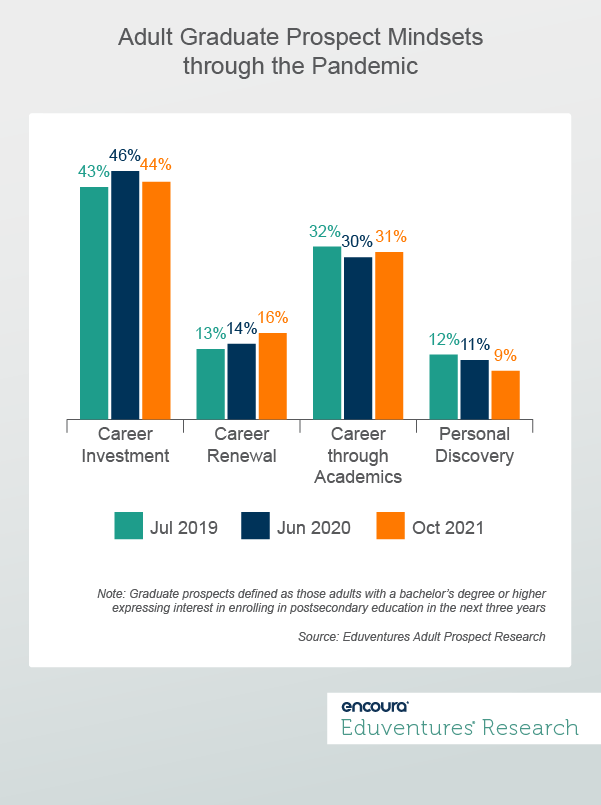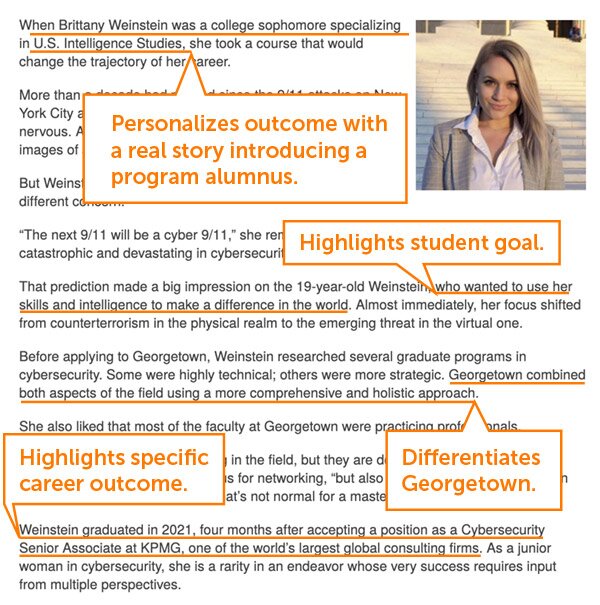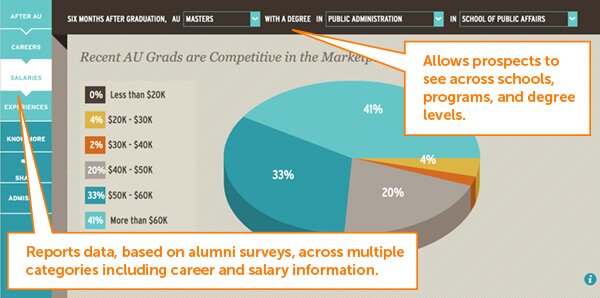The program website acts as a window to an institution, providing a pitch to prospects who, perhaps just briefly, scroll across its webpages. It’s in that moment that a school must clearly answer the critical question “why?”
Our extensive review of academic program websites has found that many schools do not go beyond the market baseline when it comes to program positioning—describing program features like the student experience, pedagogy, and career outcomes to underscore a program’s value proposition. But given the changing dynamics of the program market, it may be more important than ever—particularly at the master’s level—to get this right.
Why Program Positioning Matters
In Eduventures 2022 Master’s Market Update, published last week, we note several cautionary trends in the master’s market: Greater interest in non-degree programming has met a proliferation of alternative program options. All of this is over a period marked by an explosion of master’s programs.
Softening demand and rocketing supply have led to a more competitive and less efficient master’s market. Attention-grabbing headlines like “Financially Hobbled for Life: The Elite Master’s Degrees That Don’t Pay Off” and “Master’s Degrees are the Second Biggest Scam in Higher Education,” have become the norm.
That’s why reaching your target audience with the right program positioning, positioning that goes beyond the market baseline, is critical to cut through the market noise, insulate master’s programs from compounding market pressures, and stand out from the crowd. Today’s Wake-Up Call focuses on program positioning around career outcomes, or what students can expect from a master’s program in terms of career goals.
Getting Program Positioning Right
When it comes to program positioning, consider the market baseline as generic, vague, and oftentimes limited in terms of messaging. In the case of career outcomes positioning, messaging like “advance your career” and “earn more money”—without supporting details, facts, and data—are far more common than one might expect.
Eduventures' Adult Prospect Research™ reinforces why career outcomes messaging is so critical for the graduate market prospect pool. Our Prospective Adult Learner Mindsets (Mindsets) categorize prospective students into four groups based on their expectations and preferences for postsecondary education:
- Career Investment - those who believe that advancement in their current jobs depends on a new credential
- Career Renewal - those seeing a new credential as key to a career pivot
- Career through Academics – those who believe academic credentials will lead to personal growth and financial stability
- Personal Discovery - those seeking personal growth unrelated to career goals
While three of the four Mindsets are career-centric, they offer slight variations based on specific career motivations. Figure 1 shows the breakdown of Mindsets among graduate prospects over the course of the pandemic. Most adult prospects fall into one of the three career-oriented Mindsets.

This data also shows that from pre-pandemic to late pandemic, these mindsets were mostly stable. One exception is the slight, consistent growth in Career Renewal—perhaps the Mindset with the greatest alignment to sentiments fueling the Great Resignation. Another is the slight, consistent decline in Personal Discovery, showing the pandemic hardened career expectations even more for prospects.
When asked what the top three career expectations for their educations were (October 2021), 59% responded “earn more money,” 32% “get a better job in the same industry,” and 26% responded with either “switch careers” or “build a solid foundation for an entire career.”
These findings underscore the importance of getting program positioning right, particularly around career outcomes. They also provide more specific direction for targeted outcomes messaging. With this data in hand, Eduventures recommends the following strategies for outcomes positioning:
Show Don’t Tell
It’s one thing to say what a prospect might do after program completion, but program positioning is taken to the next level when a school is able to demonstrate actual outcomes. This is made even stronger when examples are personalized through student or alumni voices.
Show Don’t Tell Exemplar
(Georgetown University’s School of Continuing Studies)

Prove It with Data
Bold career claims without supporting evidence are just that: claims. Schools that can report actual outcomes data, whether it details actual career paths, employers, salaries, or all of the above, helps prospects visualize what is possible and how your program will help them reach their goal.
Prove it with Data Exemplar
(American University’s “We Know Success” Initiative)

Create a Career Ecosystem
Schools should take care in articulating the ecosystem in place designed to propel students toward their career goals. Information should be easy to find, up to date, and relevant. Career support? Check. Internship opportunities? Check. Focused skill development? Check.
Career Ecosystem Exemplar
(University of Florida’s Master in Sport Management)

The Bottom Line
In a tightening master’s market, program positioning—leading to program differentiation—is key. Of course, this is often easier said than done. Fragmented resources and decentralized programming are common challenges that can hinder advanced and consistent positioning at the master’s level.
Collecting and communicating labor outcomes can also be challenging. Many schools lose touch with students once the diploma is in hand—even more so among master’s students compared to undergraduates where school loyalty and affiliation is more often forged—leaving a data gap. The College Scorecard’s new program-level data can help with this, but even that has gaps.
Sticking to the positioning baseline, however, is no longer enough to cut through the market noise.
Ultimately, clear program outcomes signal clear program quality. Outcomes that are crystalized through the student/alumnus voice and supported with data and a clearly articulated career support ecosystem can elevate your positioning to the next level and signal higher quality against the field.
Never Miss Your Wake-Up Call
Learn more about our team of expert research analysts here.
Eduventures Senior Analyst at Encoura
Contact
Over the past three years, Eduventures has developed a behaviorally and attitudinally-based market segmentation of college-bound high school students we call Student Mindsets™. This year, the sample of nearly 40,000 respondents was drawn from the myOptions® database of college-bound high school juniors and seniors as well as institutional inquiry lists, allowing us to refine and validate the Mindsets in a national sample of unprecedented breadth and depth.
These market “Mindsets” get at students’ imagined paths through college by assessing the desired outcomes of college, perceived importance of college experiences, and key decision criteria at time of application.
The fundamental purpose of the Eduventures Prospective Student Research is to help institutions better understand how college-bound high school students approach one of the most important decisions of their young lives. For a teenager, the college decision looms as a complex make-or-break moment, a pivotal turn on an imagined path to adulthood.
The Program Strength Assessment (PSA) is a data-driven way for higher education leaders to objectively evaluate their programs against internal and external benchmarks. By leveraging the unparalleled data sets and deep expertise of Eduventures, we’re able to objectively identify where your program strengths intersect with traditional, adult, and graduate students’ values, so you can create a productive and distinctive program portfolio.

